How To Measure Foam Cushions

Here at Foam Direct, we help make sofas look and feel fantastic every single day! Want your sofa cushions to be the same? Follow our expert guide to measuring sofa cushions and order replacement sofa foam in just 5 easy steps. Don’t forget, we also offer fast next working day delivery. Visit our replacement sofa cushions page to begin your order or get in touch with the team for assistance.
How to Accurately Measure Cushions – Quick Guide
We’ve created a comprehensive guide to measuring your sofa cushions. Here is a quick breakdown of the steps you need to take to measure sofa cushions.
- Use existing covers for accuracy, avoid measuring cushion inners.
- Measure cover top corner to corner along seams.
- Measure depth seam to seam, between piping if it’s present.
- Avoid measuring over the middle of the cushion.
- Select a replacement foam cushion shape & input dimensions.
We recommend that you consult the rest of our guide for complete clarification. Alternatively, please feel free to contact us if you have any questions.
Cushion Measuring Tips
Whilst we recommend that you read our guide in full, here are some quick pointers you might find useful when ordering your new foam cushions.
- It’s best not to measure your existing cushion inners, as they will likely have become misshapen over time. It’s much better to measure your cushion covers. See the pictures provided for an example of the way new and old cushion sizes can differ.
- With a measuring tape or ruler, measure the covers from seam to seam including Length, Width & Thickness. If you have piped covers, measure between the piping.
- When choosing your foam grades, pay attention to the information provided on Step 3 of our ordering process. We usually recommend a soft foam for back cushions and a medium or firm foam for seat cushions depending on the measurements.
- If your cushions are made to be domed, they require a different shape than our regular Sofa Cushion Foam shape. Dacron alone will not create this domed effect. Please contact us to discuss your requirements.
- We almost always recommend Dacron & Stockinette for furniture cushions.
- Dacron is bonded to the top and bottom of your foam cushions. It measures approximately 1cm on each side. Unless you are working with particularly tight-fitting covers, we usually do not recommend that you adjust your measurements to account for this. Dacron helps to fill out your cushion covers.
- Stockinette is delicate and has a tendency to snag, ladder and tear. Providing you still have a good coverage of Stockinette over your cushion, these areas of damage should not affect the functionality.
- We are unable to apply stockinette to foam exceeding a width of 135 cm.
- Although we recommend measuring between seams, if the rise of your cushions significantly surpasses the seams of your cover, you may need to add additional depth for a fuller fit.
Cushion Measuring Guide
When it comes to measuring your armchair or sofa cushions for the first time, doubting your abilities to measure correctly is completely natural. That’s why we’ve put together this comprehensive measuring guide to help give you a better understanding of how to get the job done right!
And what better way to show you how to measure sofa cushions correctly, than by completely replacing the cushions on a sofa that has seen better days?
This guide was written under the assumption that your cushion inners can be easily removed from their covers. The cushion covers we are using in this guide have a zip allowing easy access to the inner filling.
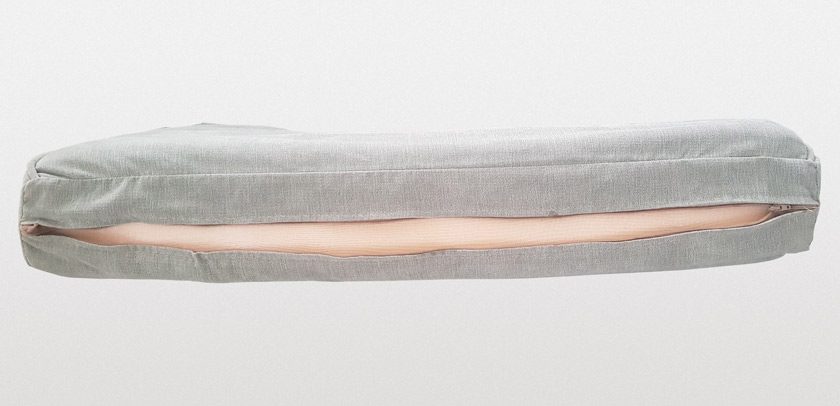
Measurements of Guide Cushions
For reference, the total measurements for the cushions in this guide were as follows. This is a standard size two-seater sofa; however, your cushion sizes will differ so do not use the measurements in this example. Instead, take your own measurements.
Back Cushions – Thickness: 10cm, Length: 47cm, Width: 77cm. Replacement cushions made using Luxury Soft Sofa Foam.
Seat Cushions – Thickness: 13cm, Length: 67cm, Width: 73cm. Replacement cushions made using Luxury Medium Sofa Foam.
Remember, it’s always best to double check your measurements. Try measuring the front and back of your cushions to check for consistency. Also, measure both cushion sets where possible.

This was the sofa before we replaced the cushions. The back cushions contained fibre filling, while the seat cushions were made from a lower quality foam that had lost its shape. These cushions were the originals supplied by the sofa manufacturer.

This is the same sofa after measuring for the new sofa cushions and fitting them. A simple change makes quite the improvement to the feel and appearance.
Things You Need to Measure Cushions
There’s not much you need to measure sofa cushions, but let’s make sure you’re properly prepared anyway.
The most important thing you’ll need when measuring for new sofa cushions is a tape measure. We’ve opted for a retractable tape measure, but a sewing/tailor tape measure will work fine as well.
Whilst you can measure on your own, an assistant would also be useful to help hold the cushion or the tape measure when you’ve run out of hands to do so.
You’ll also need a way to note down the measurements you take. We used the notepad on our phone to do so, but regular pen and paper will do just fine. Just make sure you keep them safe as you’ll need to input them on our website.
As you’ll see throughout the guide, we took a number of pictures to help you visualise the process better. You may also want to take pictures of the measurements you take for your own records, but it isn’t necessary to do so.
So, to summarise, the things you’ll need to measure for foam cushions are:
- A tape measure of your choice.
- A way to note down your measurements.
- An assistant (optional but recommended).
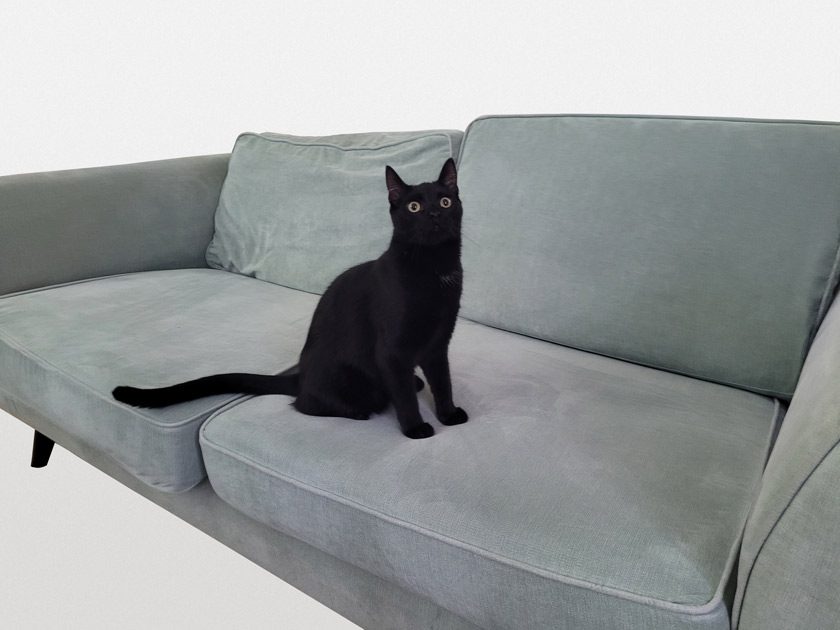
Eager pet assistants aren’t necessary, but sometimes they insist on helping out.
A Note About Measuring Apps
Nowadays, there are apps that exist that are able to approximate measurements through your phone camera. Whilst we love to marvel at the wonders of technology, in this instance, we’d suggest you avoid apps like this and stick to a regular tape measure.
We’re sure these apps have their uses in the right situations. However, we’ve often found that customers using these types of apps, have unfortunately provided us with inaccurate measurements.
Understanding Your Current Cushion Filling
There are various types of fillings for sofa cushions including foam, feather and fibrefill to name some of the more common ones. For example, the sofa we’re upgrading in this guide had a combination of both foam and fibrefill cushions. That’s to say the seat cushions were made of foam covered in Dacron and stockinette (we’ll discuss these later) and the back cushions were filled with fibres.
It’s generally quite easy to tell what your cushions are currently made of:
Fibrefill cushions feel somewhat similar to cotton wool. They also are one of the worst culprits for sagging sofa cushions over time. At first, they feel fine and comfortable, but as they receive more use they quite quickly begin to sag, lose support and require regular plumping.
If you have feather filled cushions, it should be quite easy to tell. You’ve likely already found feathers lying about the home or will notice some when removing the cushion inner from its cover. Sometimes smaller feathers can even stick out of the cushion slightly.
Foam cushions are also easily recognisable. Your cushions may be wrapped in a fine netting called stockinette. Under this, it may have a white coloured polyester wadding called Dacron. Depending on the grade, foam can come in a variety of different colours. Lighter colours can also oxidise over time resulting in a yellowish look.

One of the old fibre back cushions (left), alongside one of the new foam back cushions, complete with stockinette and Dacron (right).
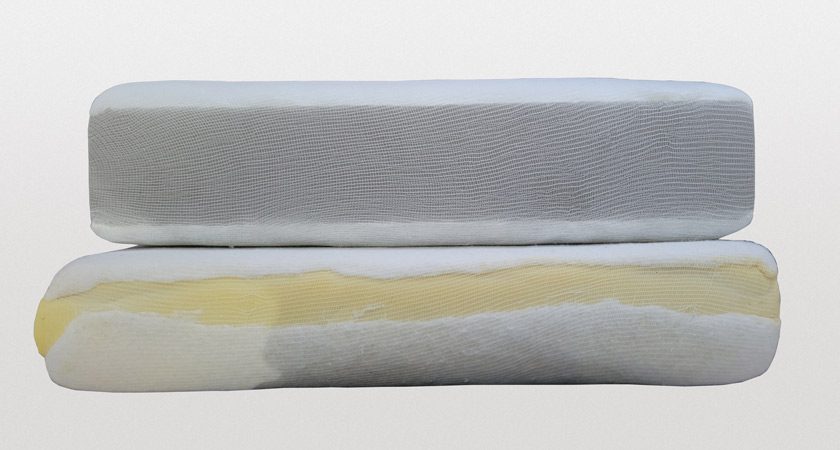
One of the old foam seat cushions (bottom), alongside one of the new seat cushions, complete with Dacron and stockinette (top). There’s a noticeable difference in the size of the cushions when placed side by side. This is why we don’t recommend you measure the old cushion.
Measuring Sofa Cushions
Now you have everything you need, we’re ready to start measuring up. This guide will be using the most popular shape we sell; Sofa Cushion Foam. This is a regular square/rectangular shape and is used for the vast majority of sofas. The instructions in this guide are still relevant to other shapes, but be sure to check what shape the furniture you’re upgrading requires and select the appropriate one.
By now, you should have a good understanding of what type of cushion filling you currently have. Because cushion fillings can compress and deform over time, we recommend not measuring your cushion inners. Instead, you should take your measurements from the cushion covers. To take your measurements, you don’t need to remove the current cushion from the cover.
In order to make new sofa cushion foam, we need the length, width and thickness; so, let’s do that now.
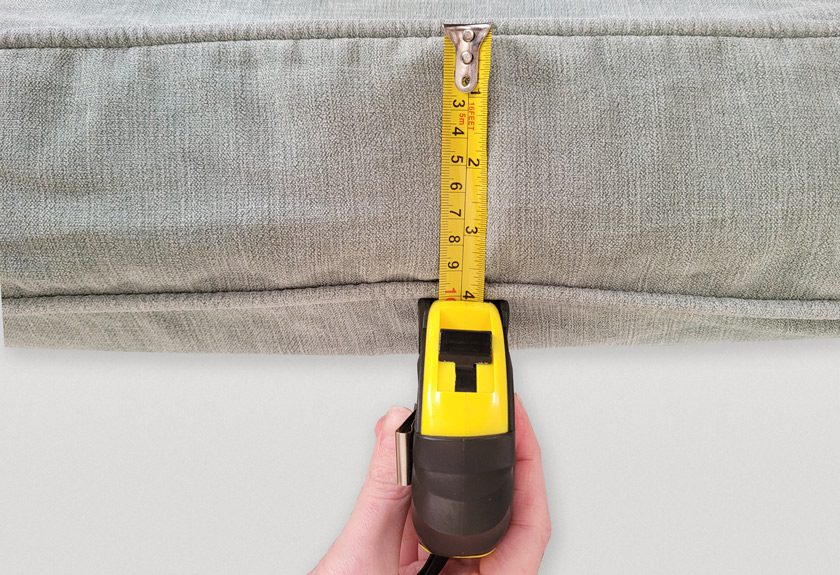
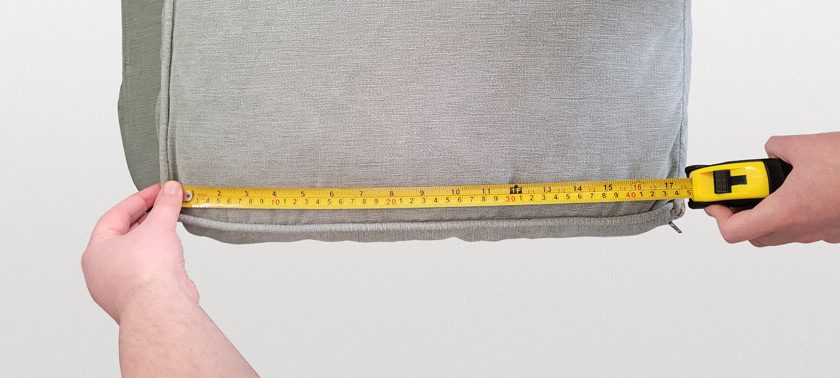
Measure the Depth, Thickness and Length of the cushions as pictured. Measure from seam to seam and in between the piping if your covers have it. If you have a retractable tape measure like the one pictured, put the end metal piece inside the piping, rather than outside. Remember to pull the covers taut as best you can.
Using your tape measure, carefully measure from seam to seam. In the example pictures, you can see that we’re taking measurements quite close to the seam. This is better practice, as if your cushions are domed, you could take inaccurate measurements by going over the middle.
Your current cushion filling may be leaving a significant amount of empty space inside your cover. As such, make sure that you pull the covers taut when measuring. This way you’ll receive a fuller filling cushion. It can be difficult to pull the cover taut and measure at the same time, which is why an assistant can be useful.
If your cushion covers have a piped edge, be sure to measure in between the piping as pictured. If you measure over the piping, the cushion you receive may be too big to fit inside your current covers. If you don’t have a piped edge on your covers, just measure from seam to seam in all directions.
In regards to measuring the width of your cushions, it’s good practice to check your measurements by measuring the front and back of your cushions. This is because the width of a cushion can sometimes vary from front to back.
Because the sofa back cushions we were measuring were fibre filled, they were particularly misshapen. In order to take a more accurate measurement, we took a moment to plump the cushions up to make them fuller in the cover. We recommend doing the same with your cushions if they are already quite misshapen.
We have a total of 25 foam shape templates to choose from. Once you’re satisfied with your measurements, simply select an appropriate shape from our templates.
Custom Shape Foam
If you can’t find the shape you’re looking for, you can always choose our custom shape option. This will allow you to specify your required measurements and select all the other options as usual.
Before you check out, at Step 5, you’ll be asked to provide a shape template for our cutters to work to. You can upload a jpg, jpeg, or png. You can also tick the “Sending Template in Post” box if you would prefer to provide a template to us this way.
If you are having trouble uploading a template image to our website, it may be because the file you are using is too large. A quick solution for this is to try compressing the image before you upload it. There are a number of free websites online that will allow you to do this.
What Type of Foam to Choose For Sofa Cushions
We stock a variety of foam grades suited to different purposes. If you’re unsure what type of foam is right for you, we do provide descriptions of each foam grade, along with our personal recommendations.
On Step 3, you’ll be asked to choose a foam grade. With each selection, you’ll be given information to the right of the button. This includes application suitability and recommendations based on thickness.
For example, depending on how thick your sofa seat cushions are, we recommend choosing a Medium or Firm feeling foam, such as Luxury Medium Sofa Foam (GB 41M) or Luxury Firm Sofa Foam (GB 39H).
Seat cushions that are 1” – 4” in thickness are best suited to a Firm foam, whereas cushions over 4” in thickness are generally better suited to a Medium foam. Of course, this doesn’t factor in your personal preferences. This suggestion is made based on how much support the foam is able to provide at certain thicknesses.
For sofa back cushions, we always suggest choosing a Soft foam (such as Luxury Soft Sofa Foam – GB 39S). When transitioning from fibre filled back cushions to foam back cushions, you’ll likely notice that they feel firmer than what you’re used to. The same applies to feathers.
Fibre cushions offer very little resistance and support when compared to foam. They deform very quickly and constantly require plumping. Foam cushions, on the other hand, offer greater longevity and are much more supportive.
Should I Include Dacron & Stockinette?
We always recommend opting to include Dacron & Stockinette with orders of sofa cushion foam. If your foam cushions are being placed inside covers, the Dacron will help to fill out the covers. The stockinette will also make it easier to insert and remove the foam.
About Dacron
Dacron is a specialised polyester material that we bond to the top and bottom of your foam. It adds loft to your cushions, helping to give them an overall fuller appearance.
Dacron can add approximately 1cm to both the top and bottom of your measurements. This is something that you should be aware of when measuring.
We’re often asked if it is necessary to remove 2cm from the width of the cushion in order to account for Dacron. In the example sofa, we took our measurements as previously instructed and did not adjust them to account for Dacron. As you’ll see from the final pictures, the foam cushions fit in the covers very well.
If you’re working with particularly tight-fitting covers, you may want to slightly adjust your measurements to account for Dacron. However, we generally suggest that you keep your measurements the same, to help better fill out the cushion covers.
About Stockinette
Stockinette goes well together with Dacron. It is a fine knitted cotton material. Without stockinette, Dacron is likely to generate friction against the inside of your cushion cover. This can lead to the Dacron becoming detached and can wear down your cushions/covers. Stockinette helps to reduce friction and makes it easier for you to insert and remove your foam.
This material has a tendency to catch and can easily ladder or tear. However, providing there is still good coverage of stockinette over your foam cushions, it should not affect the performance of it. To note, the maximum width a piece of foam can be that we are able to fit stockinette to is 135 cm.
Sofa Foam FAQ’s
Whilst we recommend that you read our guide in full, here we’ll answer some frequently asked questions from our customers.
How Much Do New Foam Cushions Cost?
The price of your new foam cushions will vary depending on the size you require and the grade of foam you choose. Not all sofa cushions are the same size, so we’re unable to provide a set price. You do not need to contact us for a quote. If you follow the steps on our homepage, our system will provide you with an instant quote for the foam you need.
What Foam Should I Choose?
We can only provide foam grade recommendations based on typical applications and given measurements, not your personal preferences. At Step 3 of our ordering system, you’ll be prompted to choose a foam grade. Here, you’ll find information regarding suitability for certain applications and what foam we recommend you choose based on measurements. For example, for sofa seat cushions of 1”- 4” in thickness, we suggest a Luxury Firm Sofa Foam. Over 4” we suggest the Luxury Medium. We always suggest you choose a soft foam for sofa back cushions such as the Luxury Soft Sofa Foam.
What Should I Do If I Can’t Find the Right Shape?
If you can’t find a matching shape from our collection of templates, we suggest you choose the Custom Shape option. Here, you’ll be able to input your measurements and make all the necessary selections. At Step 5, you’ll be able to either upload a template for us to work from or send us one by post.
I’m Having Problems Uploading My Custom Shape Template.
If you’re unable to upload your template, it may be that the file type is incorrect (we accept jpeg, jpg or png). If the file is in the correct format, but still isn’t uploading, it may be that the file you’re using is too large. Try compressing the image file and reuploading it. If you’re still having issues, please feel free to contact us for assistance.
Should I Adjust My Measurements to Account for Dacron?
Whilst Dacron adds approximately 1cm to both the top and bottom of your foam cushions, we generally suggest that you do not adjust your measurements to account for this. In our example guide, we took measurements for the sofa cushions as outlined. No adjustments were made. If you’re working with a particularly tight-fitting cover, you may find it necessary to make slight changes to account for Dacron. Usually though, leaving your measurements as-is, will help to better fill out your cushion covers.
Is There a Maximum Size Limit for Stockinette?
Yes, there is. We are only able to apply stockinette to pieces of foam that do not exceed a width of 135cm.
Why is the Foam I Currently Have A Different Colour?
Foam comes in different colours depending on its grade. Two of the most common grades of foam are blue, but foam can also be white, grey, cream, orange, grey and more. You may also notice that your current foam has a yellowish appearance. When exposed to light and air, foam can oxidise and turn a shade of yellow. This is a completely natural process and does not mean there is anything wrong with your foam.
Do You Provide Replacement Cushion Covers?
We only supply the foam for cushions and are unable to supply you with any type of cushion covers.
Still Stuck?
If you’re unsure about any particular details of your order, you can always contact a member of our team for assistance. Head over to the contact page to speak to one of our experts.

